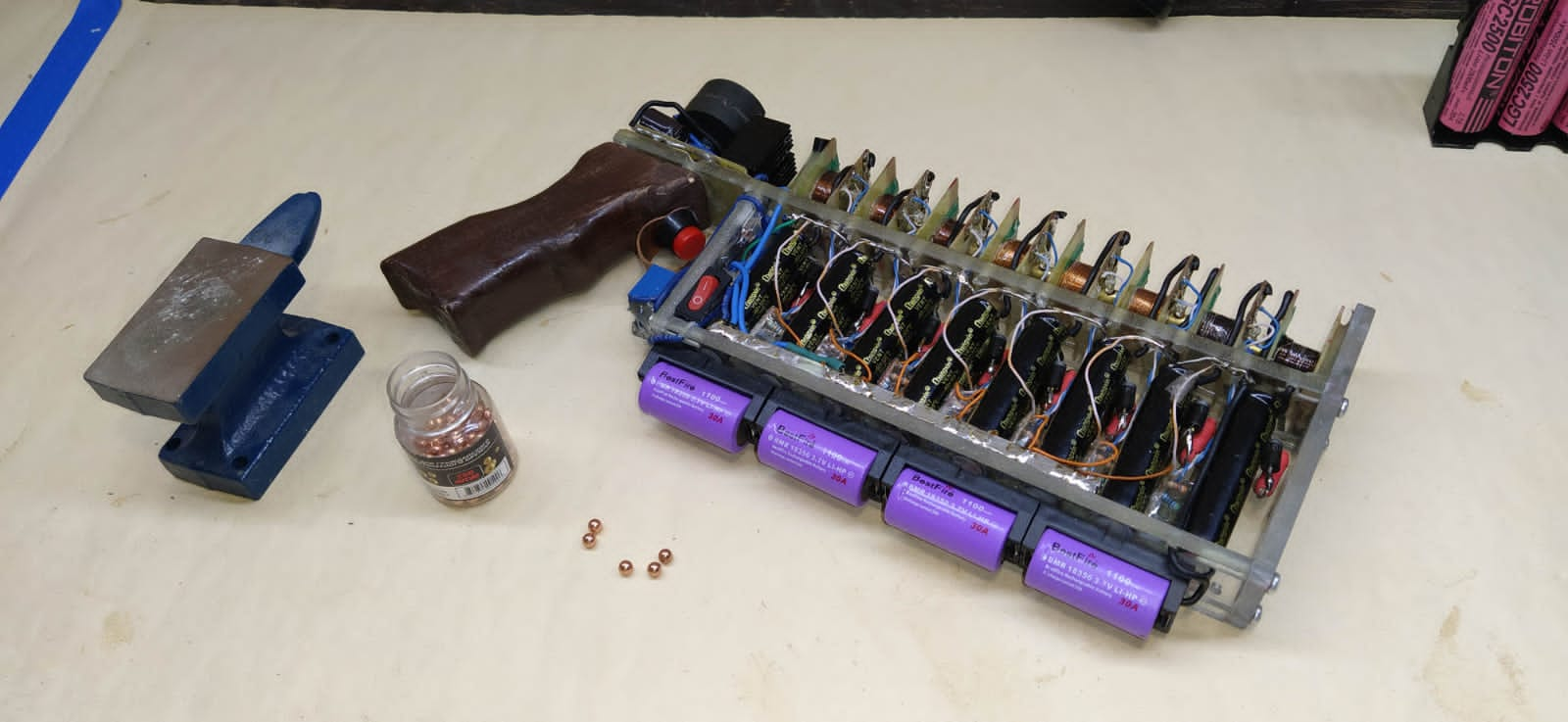| Home » Articles » Theoretical papers » Coilgun calculations |
So, as of today (January 1, 2022), my Accelerator Table contains data for 15 multi-stage coilguns, for which there is enough information to calculate the quality coefficient G (what it is and how to determine it is described in detail here). This is not a big statistic, but some conclusions can already be drawn, namely: 1) As expected, the values of the G-factor have a range from 0 to 1, and for the vast majority of more or less qualitatively designed accelerators, the values of G lie in the range of 0.25 ... 0.35. That is, getting to work, a gauss-builder who is good with his hands can count on getting the output velocity of the projectile from one-fourth to one-third of the vmax value calculated by me in this publication. Two samples stand out from this general rule - DB6L with G = 0.579 and "Ratslayer" ЩУМ-76 with G = 0.455. For the first of them, the ultra-high speed level is explained by the use of the "traveling wave" scheme - strictly speaking, this generally excludes the application of my calculation method to it, since it assumed that the coils could not work simultaneously, but turned on strictly one after the other (and for the optimal case, even with some "gap" in time). By the way, this is the only completed portable coilgun of this design known to this day. As for the "Ratslayer", its advanced characteristics are due to the use of a short (spherical) projectile - this well confirms the conclusions of my publications that the velocity of the projectile in coilgun increases with a decrease in its length.
Fig. 1. G-factor "champions" among coilguns ( by 1.01.2022). 2) From the analysis of the last two columns of the Table, it can be seen that the G-factor is more convenient for comparing different designs than the previously proposed Kx coefficient, since the Kx value fluctuates in the range from units to several tens. In addition, there is a clear correlation between the deviations of Kx and G in the direction of increase, while for small values of these coefficients there is no such correlation. In other words, if any accelerator is made qualitatively (i.e. the dimensions of the projectile and coils, as well as the time diagrams of their operation are selected correctly, and the coils themselves are wound with a maximum filling coefficient by copper), then both coefficients are likely to be large. However, for "bad" launchers, Kx can have a decent value, although G will be small (as it should be). Examples of such constructions are No. 7 and No. 12. It is easy to understand why this happens - the fact is that the G-factor, among other things, takes into account the length of the accelerator, while the Kx estimates only the output velocity of the projectile, without taking into account with what "price" it has been achieved. Therefore, for accelerators with a large number of long unoptimized windings, Kx takes inflated values. 3) The table contains accelerators in which switches with forced current interruption (MOSFET or IGBT transistors) are used - these are designs No. 3 and No. 8 (the "record holder" DB6L and the "laggard" No. 12 will not be taken into account further for the reasons mentioned above). So, it is very strange that they do not show a significantly better level of quality (values of Kx and G) compared to other coilguns using simple thyristors. This is quite surprising, because any gauss-builder knows that, in theory, the use of transistors makes it possible to better "adjust" the shape of the current in the coils to the movement of the projectile and thus increase its speed. One might think that the "non-outstanding" parameters of transistor-based coilguns are related to something else (for example, an improper selection of the shape of the windings), however, knowing the thoroughness with which such a master as James Paul approached the creation of his model, it is difficult to suspect him of this blunder... So far I have not found an explanation for this anomaly. It is probably necessary to wait until data on some more number of transistor-controlled coilguns appear in order to draw more informed conclusions...
Sincerely Yours,
Update from 23.03.2024: The table has been adjusted, the "projectile length" parameter has been introduced for each coilgun. In view of this (and also taking into account the additions made to the table over the past almost 2 years), the following changes have occurred: 1) The average values of G have increased significantly, now the "criterion of straight-armedness" can be considered the range of G = 0,45....0.,65. At the same time, it turned out that the "lagging" structures remained so even with the new calculation method. 2) Coilguns with short projectiles "suffered" the most - this is understandable, because to accelerate the balls using thyristor switching, their designer had to use an elongated coil, which is not very effective. 3) For some Gaussguns, unfortunately, information about the length of the projectile could not be found, and they were not included in the updated Table. So, just in case, I saved access to the old Table via a separate link. 4) The "champions" in terms of efficiency are coilguns with transistor switching and energy recuperation - TK-14 and DB6L, which seems completely fair. | |||
| Views: 501 | | | |||
| Total comments: 0 | |
